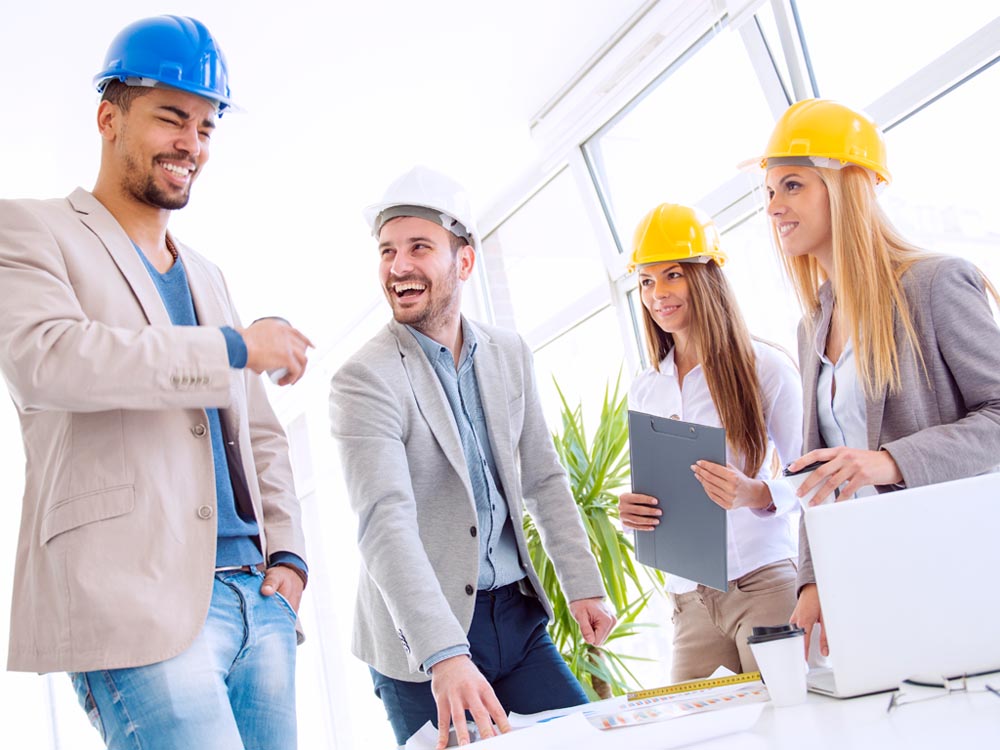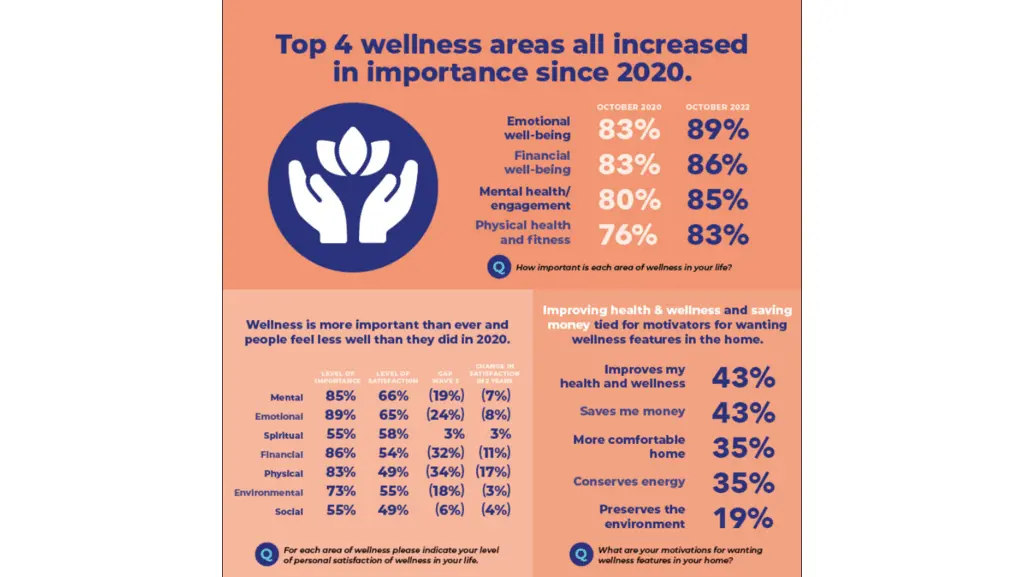
Listen up, developers, renovators, real estate agents, and builders! We both know that your customers hate the pink bathroom tile and want a neighborhood with good schools; some things remain true over time. But the biggest resident want today can be summed up in one simple word: wellness.
The Wellness Gap in the Built Environment
According to the Global Wellness Institute, wellness is “the active pursuit of activities, choices[,] and lifestyles that lead to a state of holistic health.” In the case of the American home, consumers are choosing to prioritize residences which allow for the activities/lifestyles that lead to that holistic state.
Of course, choosing to prioritize wellness does not mean it’s immediately available. Due to a variety of legacy factors, American consumers are suffering from a significant wellness gap in what they want vs. what is available. When the America at Home Study (AaHS) surveyed nearly 10,000 U.S. households (in 3 waves) about their home preferences, they set the minimum income of respondents at $50,000, a group which covers two-thirds of the population. As the below chart indicates, the only aspect of wellness that these Americans feel they have achieved (at the level matching its perceived importance) is spiritual wellness. Every other aspect of wellness falls short.
However, this is good news for real estate and construction professionals; you are able to fill a void in the market. Per the Centers for Disease Control and Prevention, 85% of wellness is determined by the built environment. Here are 7 aspects of must-have home wellness you can offer your customers.

1. Physical Wellness: Toxins and VOC Gases
America had quite a comfy relationship with lead, asbestos, and PCBs for decades, but those days are long gone…or are they? According to a proprietary summary created by the America at Home Study for ActivePure, “73% of respondents said an ‘environment free of hazards and toxins is important’ but only 55% said they had one.” This may be because many older homes still contain hazardous materials. For instance, the Department of Housing and Urban Development estimates that “40% of all [occupied] housing units” still contain some lead-based paint.
However, it’s not just older homes which have a toxin problem. Newer materials tend to offgass volatile organic compounds (VOC gases). Thus, your new home may need some additional ventilation (and/or proactive air purification) to get rid of the formaldehyde leaching from pressure-treated wood and new upholstery.
2. Mental Wellness: Wide Open Spaces
Americans want access to pleasant outdoor spaces. The American Institute of Architects (AIA)’s annual Home Design Trends survey found that most developers saw an increasing demand for both covered outdoor spaces and blended indoor/outdoor spaces in 2023. Though less popular than they were in 2022, outdoor living spaces remain the most popular special room improvement after home offices. Meanwhile, the desire for green fencing options increased when compared to 2022.
The America at Home Study agrees with this conclusion. They found that respondents rated a private outdoor space and/or garden as the most important home feature for their personal wellness.
However, that doesn’t mean such a feature is easy to come by. Per AaHS, slightly over half of all renters were willing to forgo a private yard in order to afford a home, as long as they retained some access to outdoor space. Yet even this compromise is out of reach for some. Analyzing AIA data, Forbes theorized that a slight yet surprising decline in demand for walkable neighborhoods was due to a scarcity of available housing in said neighborhoods. As the United States is (perhaps) the only wealthy nation whose population is expected to significantly increase over the next few decades, builders have an ongoing opportunity to create more housing in neighborhoods which promote outdoor wellness.
3. Environmental Wellness: Sustainability and Resilience
While Americans may disagree on how best to help the environment, they care about it. The American Institute of Architects, for instance, found an increasing demand for sustainable materials in exterior building construction. As Builder Online reports regarding the AaHS data:
“[Respondents] top fears were “inflation” (62%), “economy/my job” (36%), and “climate change” (31%). This says to us that [an] attainable product, not only in terms of initial purchase price but also ongoing operating costs with consideration for minimizing the impact on the environment, is critical.” (emphasis ours).
Perhaps because of this concern about climate change, there appears to be a statistically noticeable increase in demand for homes which are prepared for natural disasters. AIA found that requests for both “hurricane-resistant/tornado-resistant” homes and “wind/impact[-]resistant” home products are on the rise.
4. Financial Wellness: Energy Efficiency
Concern for the environment is most visible when it results in energy efficiency. According to AaHS, “In all 3 waves of the study, ‘Greater Technology/Energy Efficiency’ was the #1 thing consumers say is missing and they are willing to pay for.” Wellness itself was demonstrably the motive behind this increase, being the top “purchase motivator for choosing technologies and features that conserve energy and the environment.”
5. Emotional Wellness: Safe Spaces
Most people don’t want to think about COVID-19 anymore. Yet buried in the data of various surveys are hints that the trauma (and subsequent need for safety) remains:
- Per the National Association of Home Builders, sales of single-family homes remain higher than their pre-pandemic levels (at least for new construction). This suggests that those with the money to do so are buying/building spaces which can remain a refuge from the pathogens of others.
- Per HomeAdvisor, the top reason Americans don’t invite guests to their homes is that they “don’t like others to intrude on their space.” Out of more than 1,000 homeowners, more than one-quarter of respondents gave this answer!
- Per the AIA, mudrooms are increasing in popularity. This undoubtedly reflects the simple desire for easier cleaning, but might it also reflect the desire for a barrier between the safe space of the home and the germs of the outside world?
You don’t need to rely on psychological hints, however. Consumers are quite happy to tell statisticians their concerns directly. As reported by Builder Online, Wave 3 of AaHS found that:
“When we asked people what “home” means to them, not surprisingly in the middle of a pandemic most said ‘safety.’ It was the top answer for 89% of people in October 2020. Post-pandemic it’s still No. 1, this time for 93% of respondents.” (emphasis ours)
6. Social Wellness: Welcoming Spaces
Of course, it's not all about, or even mostly about, avoiding the bad. Builder Online continues, “All other factors, including ‘comfort,’ ‘relaxation, and ‘family,’ also rose over the past two years, telling us the home is more important than ever.” Reporting on a separate study by Kantar, Builder Online found that increased quality time together is the third most enduring home behavior change post-pandemic. This may be why AIA found that finished basements and attics are increasing in popularity. And while a large segment of the population may not like inviting guests, they are outnumbered by a slight majority (59%) who “say they like having other people over their house for dinners, entertaining, and hanging out” (HomeAdvisor).
7. Wellness Begins with the Air You Breathe™
Air quality affects nearly every aspect of wellness. Thus, the right air purification can help developers, renovators, real estate agents, and builders meet customer needs.
- Physical and Mental Wellness: The physical impact of airborne contaminants is well known, but did you know that air quality can affect cognition as well? High levels of particulate matter have been shown to have a variety of both long- and short-term cognitive effects. The HEPA filters found in many ActivePure devices are rated to catch these particles. As for other contaminants, ActivePure® Technology is proven to reduce up to 99.9% of many common viruses, bacteria, and mold spores on both air and surfaces.
- Environmental and Financial Wellness: The right air purification is also an energy-efficient technology. Most devices containing ActivePure® Technology use only as much energy as a light bulb. Plus, they can reduce contaminants indoors without the need for high-grade filters that strain (and sometimes break) home HVAC systems. ActivePure systems designed for ductwork, such as the Induct or Air Scrubber products, work with and can even help protect existing HVAC systems.
- Emotional and Social Wellness: With all those guests hanging out in their new basement rumpus room, the last thing your customers want is for it to still smell like a basement. Plus, one of those new guests is bound to bring a new respiratory virus as a housewarming gift. Wouldn’t it be nice to offer some extra peace of mind in the form of ActivePure® Technology?
We’re not just asking you to take our word for it. ActivePure will soon be featured in AaHS’s “The Picket Fence” concept home, which demonstrates how healthy and efficient future homes can be. As for our past work in the field, you can hear from happy customers yourself on our video channel.


